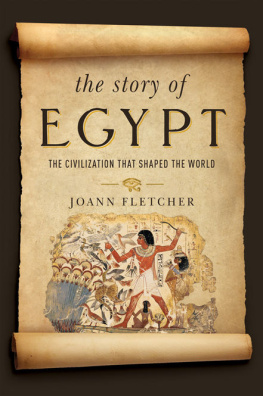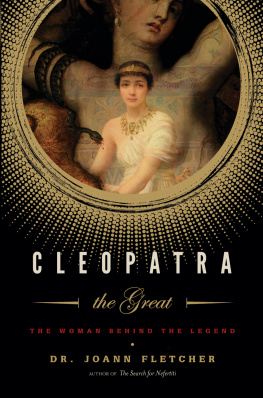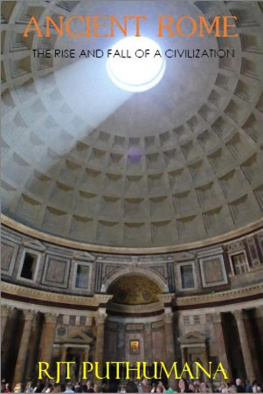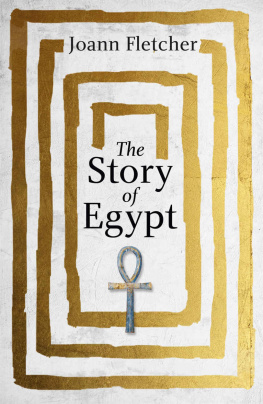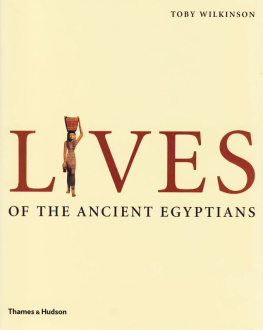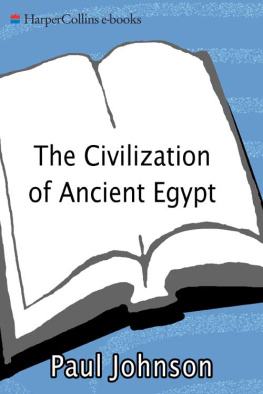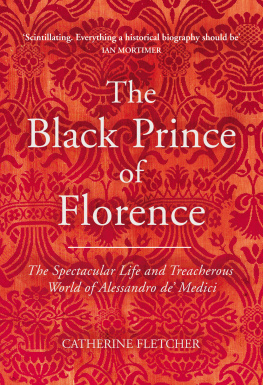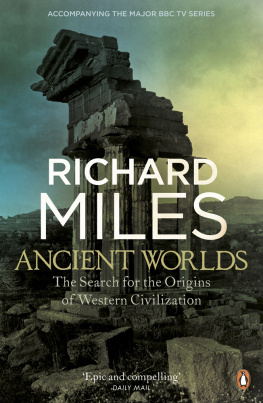the story of
E G Y P T
THE CIVILIZATION THAT SHAPED THE WORLD
_______________
JOANN FLETCHER

PEGASUS BOOKS
NEW YORK LONDON
For Stephen and Eleanor


Contents
This is the story of Egypt the story of its ancient culture, and how this first came into being, how it developed and flourished, apparently declined, and then finally came to a notional end.
Retold countless times down the centuries, there are as many versions of Egypts story as there are those to tell it. And so this is simply my version, featuring the people, places and events that have fascinated me my whole life.
And it is fair to say Egypt has pretty much been my life. Familiar and accessible through my familys books, photographs and wartime recollections, the ancient Egyptians were, it seems, always around during my childhood, as the inspiration for my earliest drawings, the way I dressed my dolls, the things I read and collected.
The defining moment came in 1972, when the Tutankhamen exhibition arrived in Britain. His beautiful golden face appeared everywhere in the media frenzy for all things pharaonic, and Egyptologists of the day were regularly asked for quotes by the press. The revelation that people actually studied ancient Egypt as their job seemed to me both astonishing and wonderful so at the age of six, I announced that I was going to do that too.
Admittedly it was not a particularly straightforward career choice for a young girl growing up in the Yorkshire mining town of Barnsley in the 1970s, when ancient Egypt was certainly not on the national curriculum. Assuming I was completely deluded, careers advisors insisted that teaching or nursing were my only realistic alternatives, while letters seeking the advice of curators and academics likewise drew a blank.
Yet my mind was made up. Falling head over heels in love with the country, its people, and its past on my first trip to Egypt at the impressionable age of fifteen, I worked all the harder to gain the required exam results for acceptance on to my dream degree course Egyptology and ancient history. Initially studying as an undergraduate, then as a postgraduate, I am now lucky enough to teach the subject myself, working with universities, museums, laboratories and television companies, and spending time in Egypt, with my adopted family, with my friends, and with some of my Egyptological heroes.
And this has led to a whole range of fascinating projects I could never have imagined as a child; not only to rediscover the past, but to try to recreate it, to better understand how the Egyptians lived, how they died, and how they then lived on through mummification, preserving themselves for the future.
Work that has taken me all over Egypt, as far afield as Yemen, Sudan and South Africa not to mention Barnsley, Harrogate and Wigan the results of diverse projects in diverse places, has certainly caused me to question some long-held notions about Egypts ancient past and its people, meaning that my story of Egypt inevitably varies from more traditional histories.
For these can sometimes almost suggest that an elite group of men sprang fully formed from the banks of their great river, remaining in splendid isolation for the last three thousand years BC, before apparently disappearing as mysteriously as they had arrived, their exotic and arcane legacy largely impenetrable to the modern west.
Yet for all their esoteric reputation, the Egyptians were actually the most practical and inventive of people, whose view of their world quite logical when seen through their eyes is really no more curious than our own.
And certainly all the elements that made up ancient Egypt were already in place far earlier, lasted far longer and covered a much wider area than is generally acknowledged, certainly far beyond the narrow confines of the Nile Valley, and much of traditional Egyptology.
So by pushing back boundaries beyond limited time frames, beyond current borders, and beyond a male elite of kings and priests, there emerges a rather more balanced kind of story.
Spanning millennia, continents and classes, it is a story initiated by climate change and migrating populations, brought together in a very particular environment a desert irrigated by a single great river, whose fertile banks nurtured the greatest culture the world has ever seen.
Jo Fletcher
Yorkshire
2015
Within their rich body of myth and legend, the Egyptians believed that in the beginning was complete darkness, a darkness made up of the infinite, formless waters from which the very first mound of earth appeared.
Yet creation was no unique event; it reoccurred every single year when the world was created anew from the annual Nile flood, when the whole country is converted into a sea, as one ancient eyewitness claimed.
Believed to originate in a cavern in the furthest reaches of southern Egypt, the floodwaters arrival was heralded by the rising of the Morning Star (Sirius), which the Egyptians identified as the glittering goddess Sothis, the most beautiful of all, at the start of a happy year.
As the Niles welcome waters began to rise and spill out across the land, they literally brought life, hugging the fields, so each is reborn. As the meadows laugh when the riverbanks are flooded, it was said that the whole land leaps for joy! as people threw flowers, offerings and even themselves into the waters.
Just as the rhythms of the river dictated the pace of life as its levels rose and fell each year, so its annual cycle formed a structured calendar of three seasons the inundation (akhet), followed by spring planting (peret) and summer harvest (shemu). Each year the receding waters would reveal a revitalised land filled with the promise of new life, a layer of rich black wet silt, sparkling in the sunshine, within which bountiful harvests could grow. In fact, the silt was such a stark contrast with the sterile sands of the surrounding deserts that Egypt was very clearly a land of two parts, a dual landscape of Red Land, Black Land: deshret and kemet.
Since this phenomenon was witnessed along the whole length of the rivers course as it flowed its 750 miles from south to north, each separate region of Egypt had its own explanation of these annual events, explanations that took the form of creation sagas in which their own local deity took the starring role.
In Memphis, creation was regarded as the handiwork of Ptah, who had combined masculine and feminine elements within the primeval waters to emerge as the risen land itself. Then, having simply thought the world into being, Ptah, the Father of the gods as well as the Mother who gave birth to all the gods, summoned up all living things by simply speaking their names, in the earliest known version of the familiar refrain In the Beginning was the Word.
At nearby Sais, a more exuberant variation on this word of God scenario involved the thunderous laughter of Neith the Terrifying One, the armed creator goddess who alone gave birth to the sun. And as one who could be both the male who acts the female, the female who acts the male, she could at any time make the sky crash down and destroy all she had made, personifying the two extremes of life and death, inherent in the floodwaters and within the sun itself.
Next page
